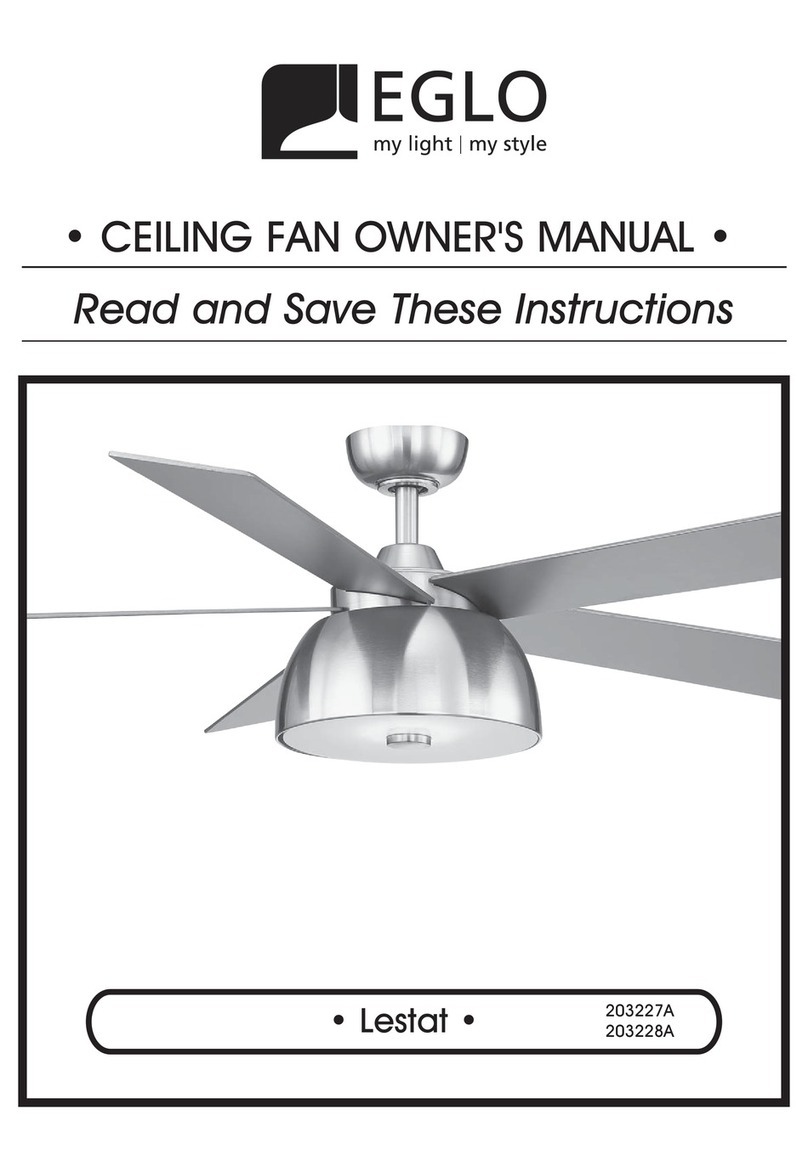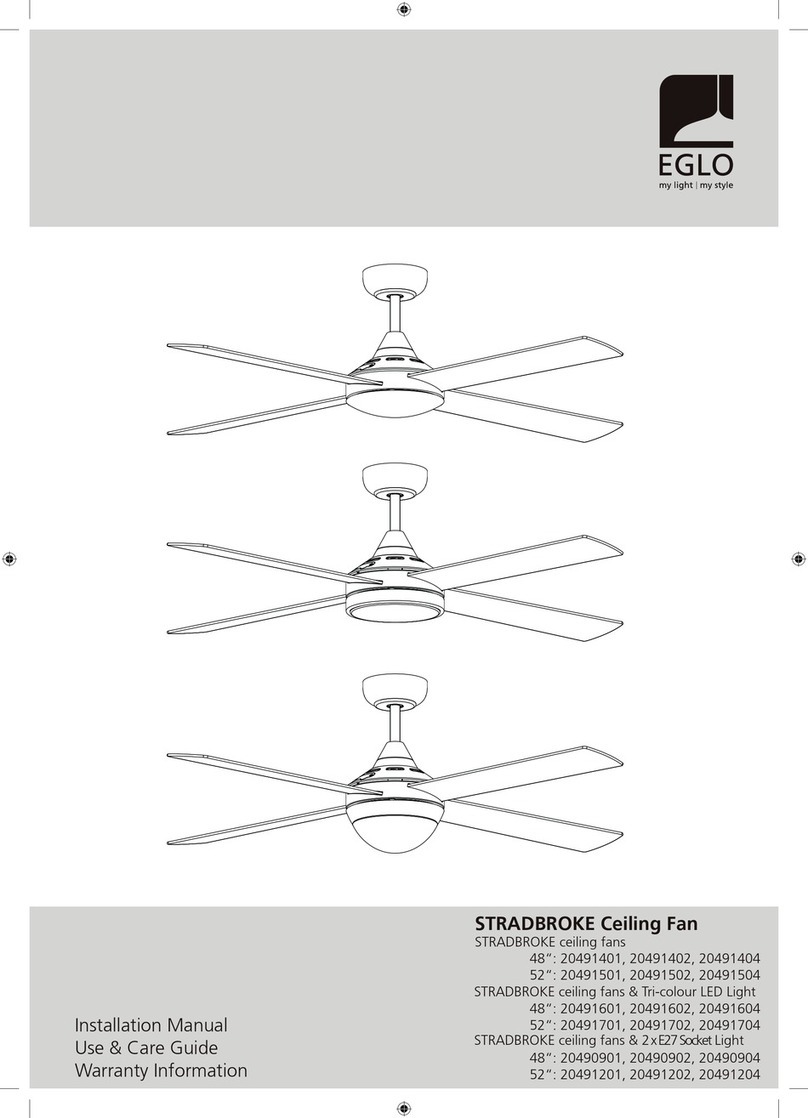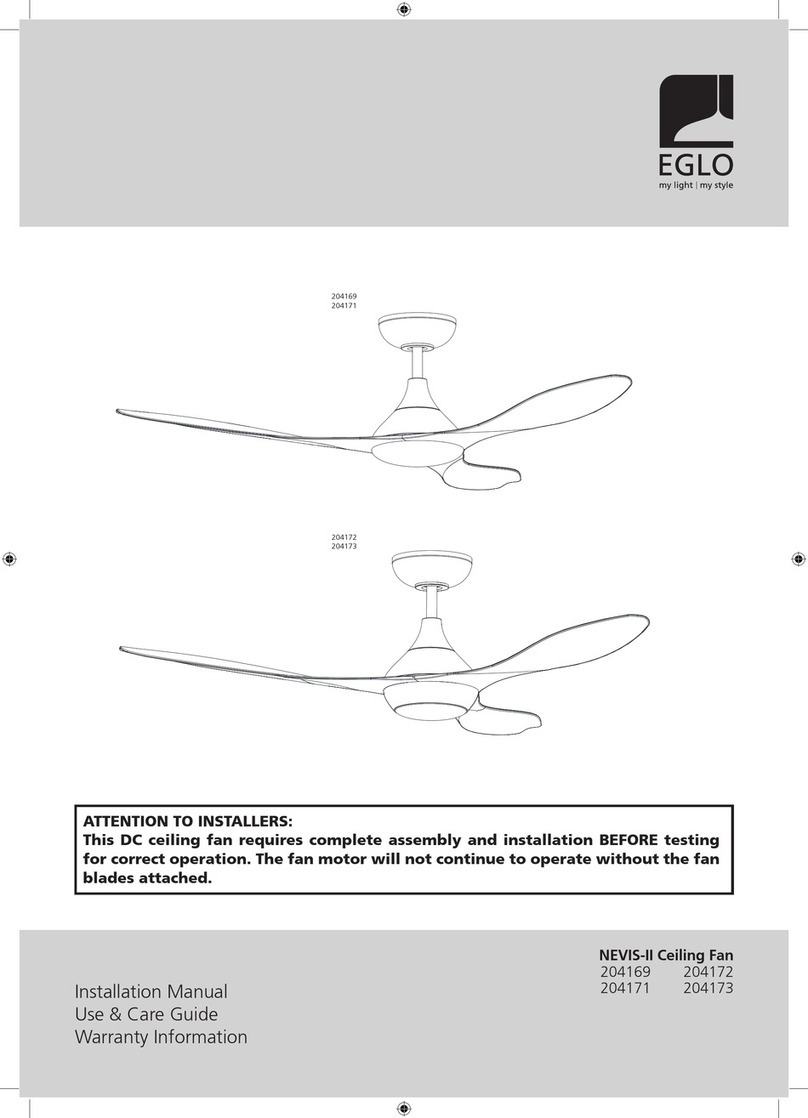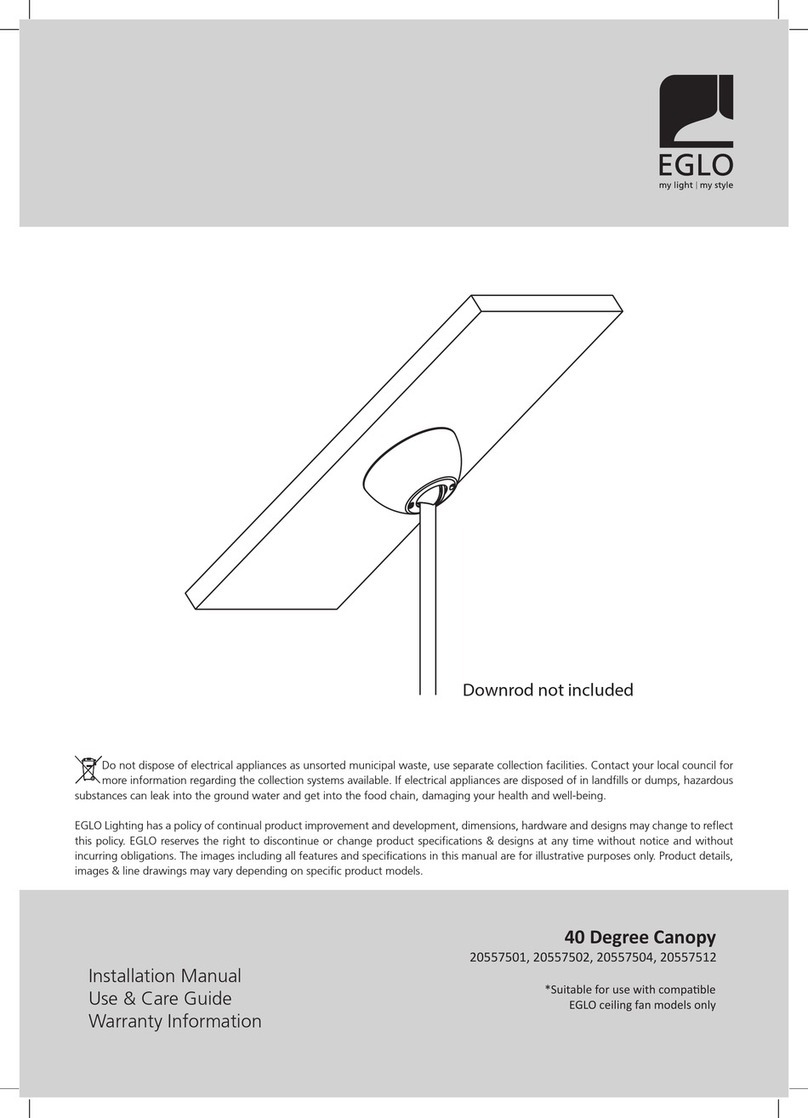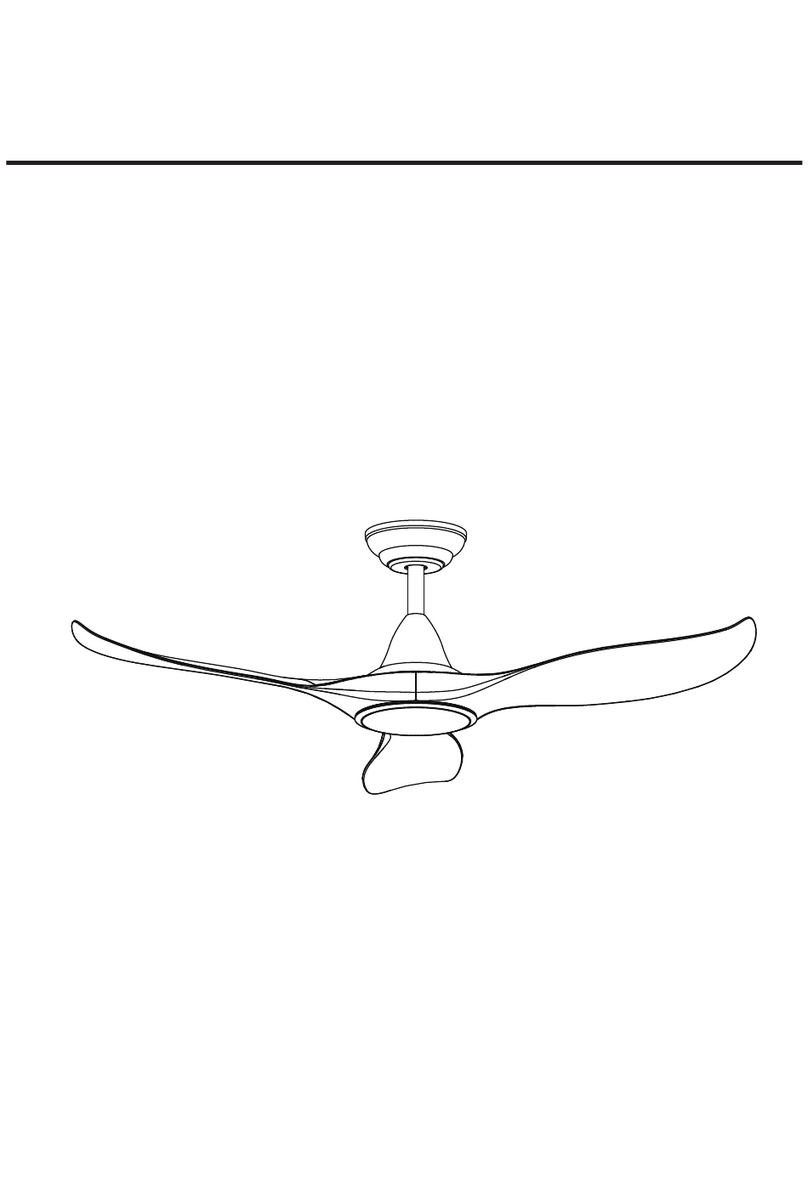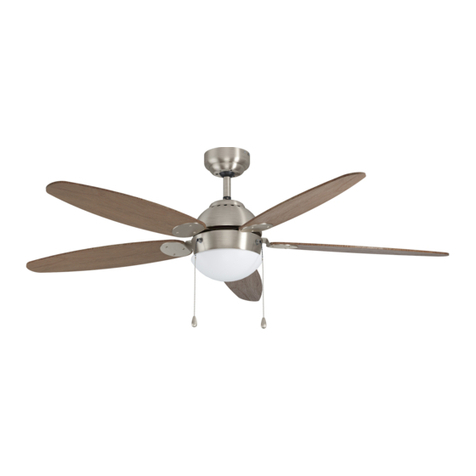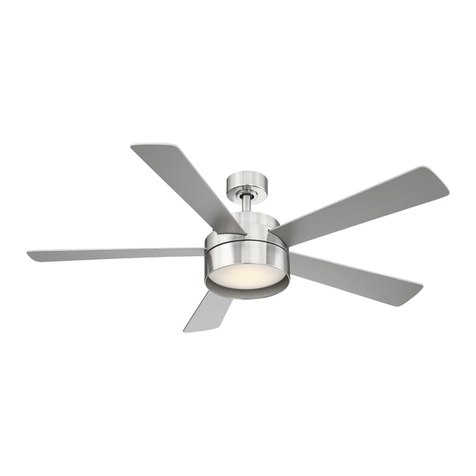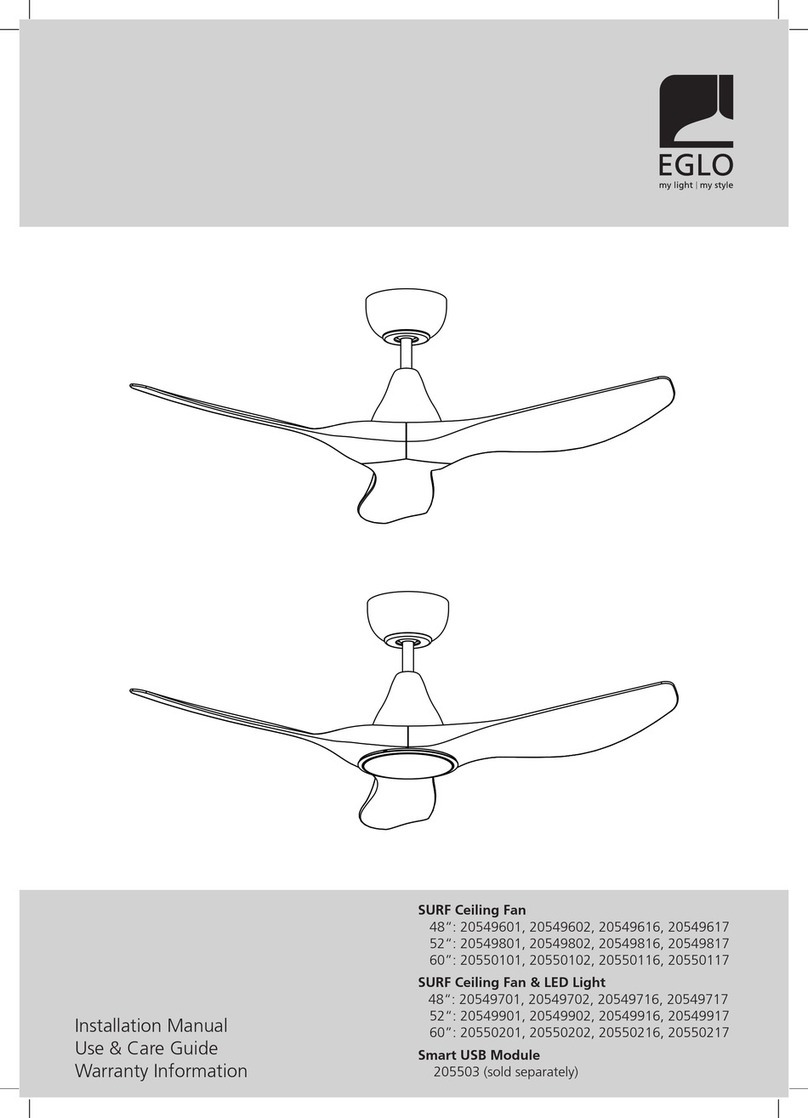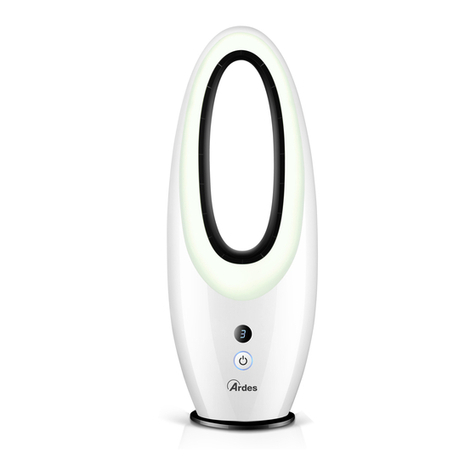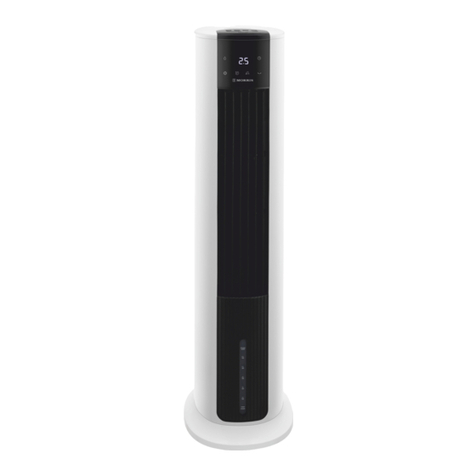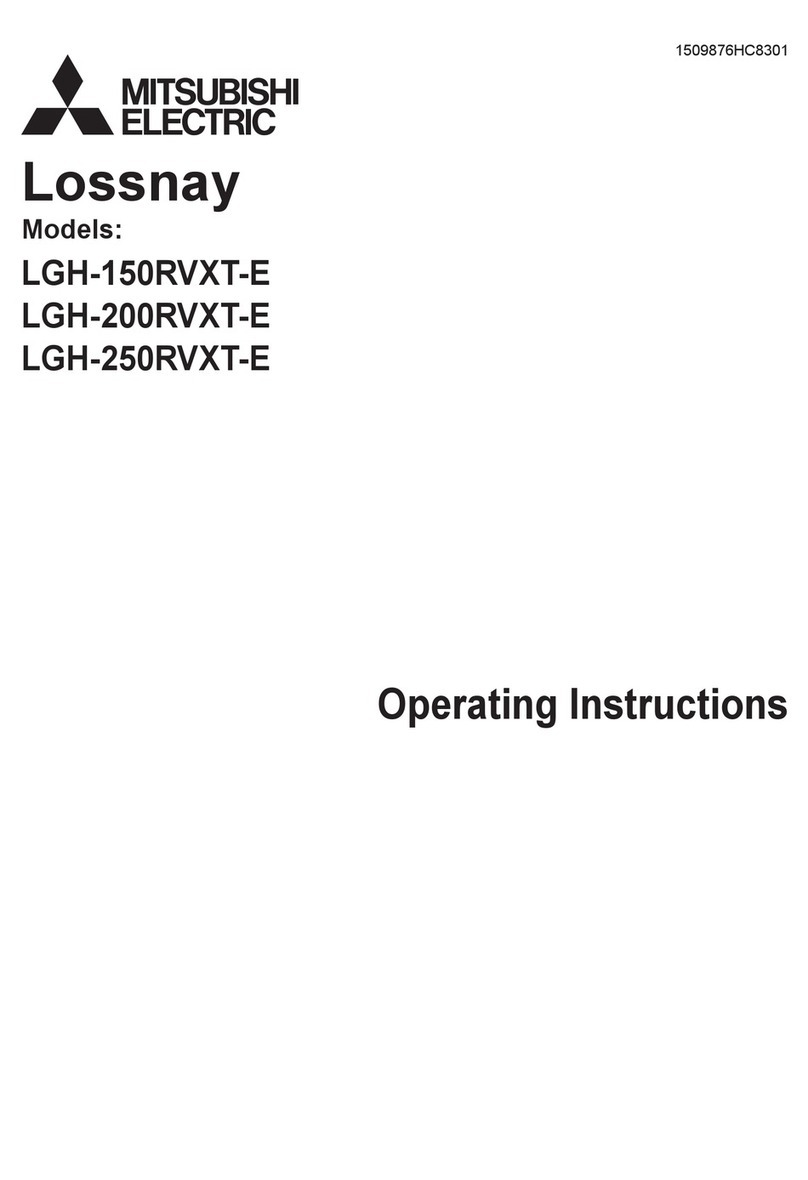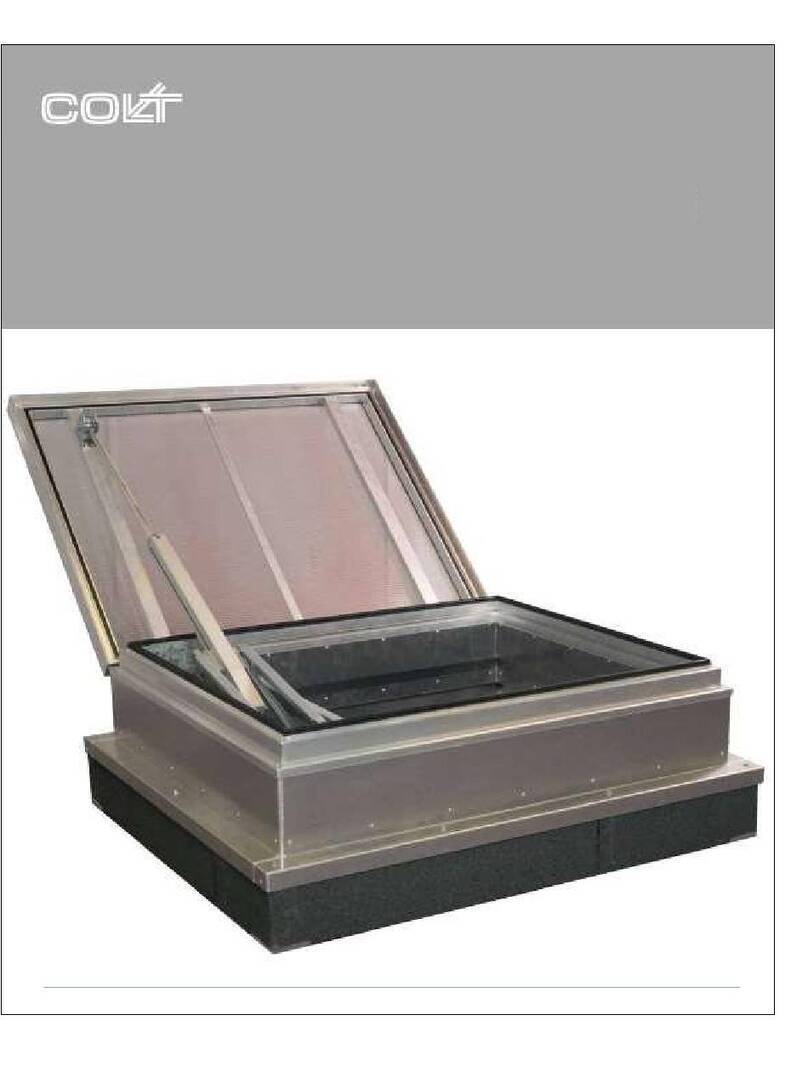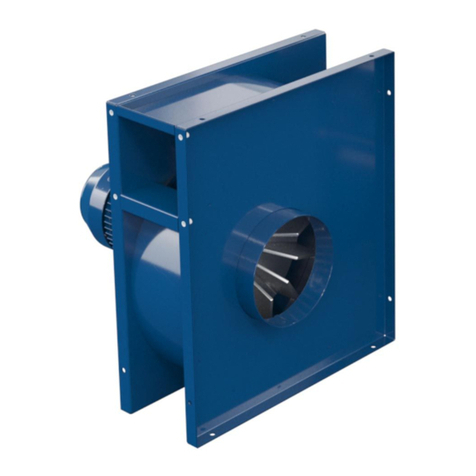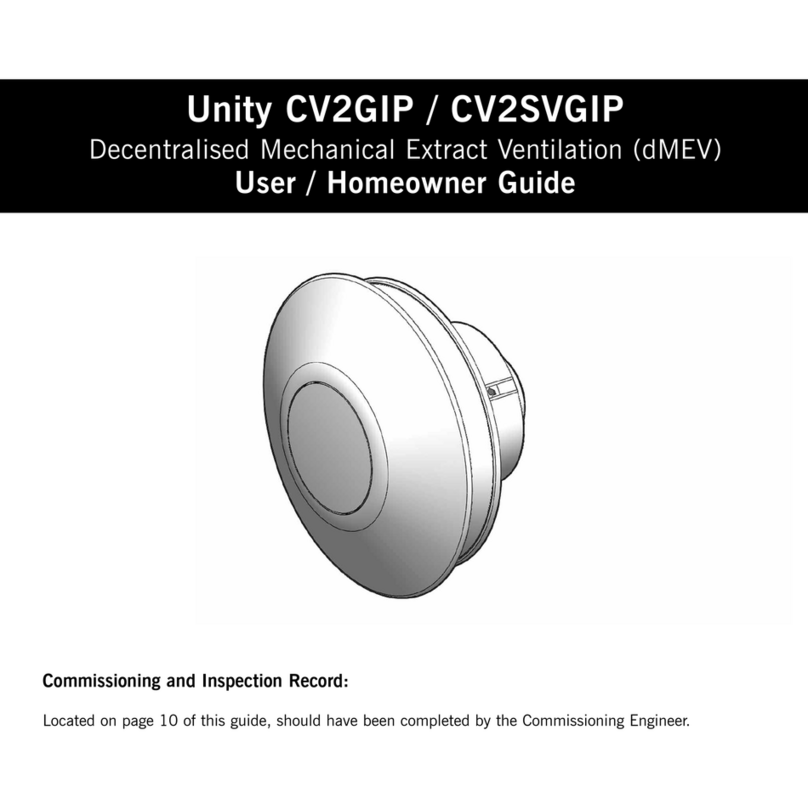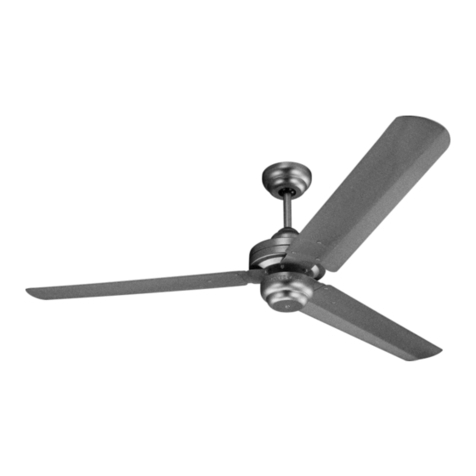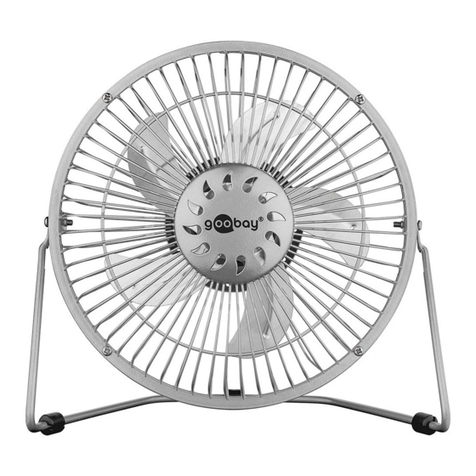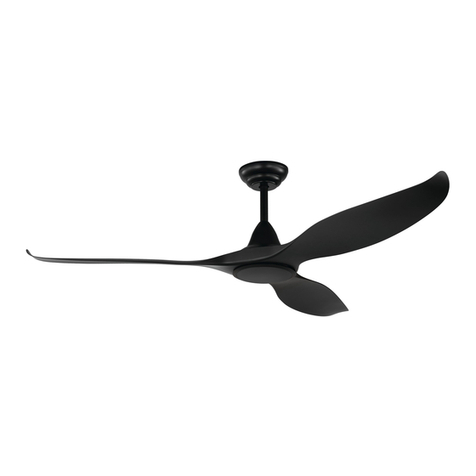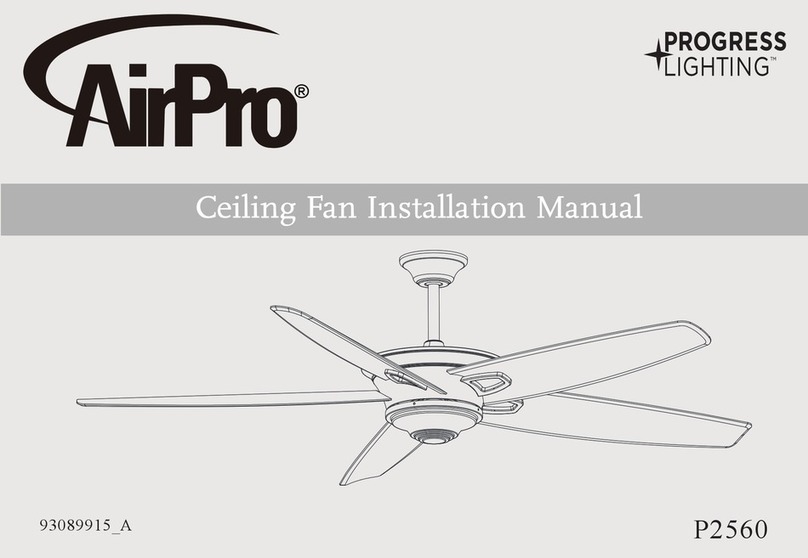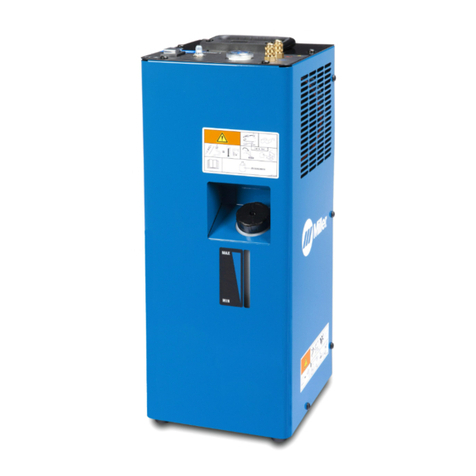
TROUBLE SHOOTING
WARNING:
CEILING FAN MUST BE SWITCHED OFF AND ISOLATED
BEFORE COMMENCING ANY TROUBLE SHOOTING
WOBBLE / BALANCE:
Please note that all ceiling fans are not the same, even fans of the same model, some may move more or less than others. Movement of
a few centimetres is quite acceptable, and does not suggest the fan will fall if installed correctly.
All ceiling fan blades are weighed and grouped by weight. It is impossible to eliminate wobble altogether and it should not be considered
a fault. Ceiling fans tend to move during operation because they are not rigidly mounted.
To reduce the fan wobble:
• Check that all screws which fix the mounting bracket and down rod are tightly secured.
• Wobble may result from inconsistent blade level. Check this by measuring from the tip of the blade to the ceiling, and
repeat on every blade.
If the measurements are different:
1. Check that the blade screws are not overly tightened, or loose, causing the tip of the blade to be unlevelled.
2. Out of shaped blades can unbalance the fan and cause wobble. Check by removing all blades and stacking on a flat level surface,
and ensure all blades are a uniform shape.
3. Interchanging blades from the same model can redistribute the weight and result in smoother operation.
WARNING: If unusual oscillating movement is observed, stop using the ceiling fans
immediately, and contact the customer care hotline.
NOISE:
When it is quiet, especially at night, you may hear occasional small noises. Slight power fluctuations and frequency signals superimposed
in the electricity for off-peak hot water control, may cause a change in fan motor noise. THIS IS NORMAL.
Please allow a 24-hour “settling-in” period, as most noises associated with a new fan disappear during this initial period. Please note that
this is not a product fault and as such is not covered under warranty. All electric motors make noise to some extent!
10 TORQUAY Ceiling Fan
TROUBLE SHOOTING
WARNING:
CEILING FAN MUST BE SWITCHED OFF AND ISOLATED
BEFORE COMMENCING ANY TROUBLE SHOOTING
WOBBLE / BALANCE:
Please note that all ceiling fans are not the same, even fans of the same model, some may move more or less than others. Movement of
a few centimetres is quite acceptable, and does not suggest the fan will fall if installed correctly.
All ceiling fan blades are weighed and grouped by weight. It is impossible to eliminate wobble altogether and it should not be considered
a fault. Ceiling fans tend to move during operation because they are not rigidly mounted.
To reduce the fan wobble:
• Check that all screws which fix the mounting bracket and down rod are tightly secured.
• Wobble may result from inconsistent blade level. Check this by measuring from the tip of the blade to the ceiling, and
repeat on every blade.
If the measurements are different:
1. Check that the blade screws are not overly tightened, or loose, causing the tip of the blade to be unlevelled.
2. Out of shaped blades can unbalance the fan and cause wobble. Check by removing all blades and stacking on a flat level surface,
and ensure all blades are a uniform shape.
3. Interchanging blades from the same model can redistribute the weight and result in smoother operation.
WARNING: If unusual oscillating movement is observed, stop using the ceiling fans
immediately, and contact the customer care hotline.
NOISE:
When it is quiet, especially at night, you may hear occasional small noises. Slight power fluctuations and frequency signals superimposed
in the electricity for off-peak hot water control, may cause a change in fan motor noise. THIS IS NORMAL.
Please allow a 24-hour “settling-in” period, as most noises associated with a new fan disappear during this initial period. Please note that
this is not a product fault and as such is not covered under warranty. All electric motors make noise to some extent!
10 TORQUAY Ceiling Fan
TROUBLE SHOOTING
WARNING:
CEILING FAN MUST BE SWITCHED OFF AND ISOLATED
BEFORE COMMENCING ANY TROUBLE SHOOTING
WOBBLE / BALANCE:
Please note that all ceiling fans are not the same, even fans of the same model, some may move more or less than others. Movement of
a few centimetres is quite acceptable, and does not suggest the fan will fall if installed correctly.
All ceiling fan blades are weighed and grouped by weight. It is impossible to eliminate wobble altogether and it should not be considered
a fault. Ceiling fans tend to move during operation because they are not rigidly mounted.
To reduce the fan wobble:
• Check that all screws which fix the mounting bracket and down rod are tightly secured.
• Wobble may result from inconsistent blade level. Check this by measuring from the tip of the blade to the ceiling, and
repeat on every blade.
If the measurements are different:
1. Check that the blade screws are not overly tightened, or loose, causing the tip of the blade to be unlevelled.
2. Out of shaped blades can unbalance the fan and cause wobble. Check by removing all blades and stacking on a flat level surface,
and ensure all blades are a uniform shape.
3. Interchanging blades from the same model can redistribute the weight and result in smoother operation.
WARNING: If unusual oscillating movement is observed, stop using the ceiling fans
immediately, and contact the customer care hotline.
NOISE:
When it is quiet, especially at night, you may hear occasional small noises. Slight power fluctuations and frequency signals superimposed
in the electricity for off-peak hot water control, may cause a change in fan motor noise. THIS IS NORMAL.
Please allow a 24-hour “settling-in” period, as most noises associated with a new fan disappear during this initial period. Please note that
this is not a product fault and as such is not covered under warranty. All electric motors make noise to some extent!
10 TORQUAY Ceiling Fan
TROUBLE SHOOTING
WARNING:
CEILING FAN MUST BE SWITCHED OFF AND ISOLATED
BEFORE COMMENCING ANY TROUBLE SHOOTING
WOBBLE / BALANCE:
Please note that all ceiling fans are not the same, even fans of the same model, some may move more or less than others. Movement of
a few centimetres is quite acceptable, and does not suggest the fan will fall if installed correctly.
All ceiling fan blades are weighed and grouped by weight. It is impossible to eliminate wobble altogether and it should not be considered
a fault. Ceiling fans tend to move during operation because they are not rigidly mounted.
To reduce the fan wobble:
• Check that all screws which fix the mounting bracket and down rod are tightly secured.
• Wobble may result from inconsistent blade level. Check this by measuring from the tip of the blade to the ceiling, and
repeat on every blade.
If the measurements are different:
1. Check that the blade screws are not overly tightened, or loose, causing the tip of the blade to be unlevelled.
2. Out of shaped blades can unbalance the fan and cause wobble. Check by removing all blades and stacking on a flat level surface,
and ensure all blades are a uniform shape.
3. Interchanging blades from the same model can redistribute the weight and result in smoother operation.
WARNING: If unusual oscillating movement is observed, stop using the ceiling fans
immediately, and contact the customer care hotline.
NOISE:
When it is quiet, especially at night, you may hear occasional small noises. Slight power fluctuations and frequency signals superimposed
in the electricity for off-peak hot water control, may cause a change in fan motor noise. THIS IS NORMAL.
Please allow a 24-hour “settling-in” period, as most noises associated with a new fan disappear during this initial period. Please note that
this is not a product fault and as such is not covered under warranty. All electric motors make noise to some extent!
10 TORQUAY Ceiling Fan
TROUBLE SHOOTING
WARNING:
CEILING FAN MUST BE SWITCHED OFF AND ISOLATED
BEFORE COMMENCING ANY TROUBLE SHOOTING
WOBBLE / BALANCE:
Please note that all ceiling fans are not the same, even fans of the same model, some may move more or less than others. Movement of
a few centimetres is quite acceptable, and does not suggest the fan will fall if installed correctly.
All ceiling fan blades are weighed and grouped by weight. It is impossible to eliminate wobble altogether and it should not be considered
a fault. Ceiling fans tend to move during operation because they are not rigidly mounted.
To reduce the fan wobble:
• Check that all screws which fix the mounting bracket and down rod are tightly secured.
• Wobble may result from inconsistent blade level. Check this by measuring from the tip of the blade to the ceiling, and
repeat on every blade.
If the measurements are different:
1. Check that the blade screws are not overly tightened, or loose, causing the tip of the blade to be unlevelled.
2. Out of shaped blades can unbalance the fan and cause wobble. Check by removing all blades and stacking on a flat level surface,
and ensure all blades are a uniform shape.
3. Interchanging blades from the same model can redistribute the weight and result in smoother operation.
WARNING: If unusual oscillating movement is observed, stop using the ceiling fans
immediately, and contact the customer care hotline.
NOISE:
When it is quiet, especially at night, you may hear occasional small noises. Slight power fluctuations and frequency signals superimposed
in the electricity for off-peak hot water control, may cause a change in fan motor noise. THIS IS NORMAL.
Please allow a 24-hour “settling-in” period, as most noises associated with a new fan disappear during this initial period. Please note that
this is not a product fault and as such is not covered under warranty. All electric motors make noise to some extent!
10 TORQUAY Ceiling Fan
TROUBLE SHOOTING
WARNING:
CEILING FAN MUST BE SWITCHED OFF AND ISOLATED
BEFORE COMMENCING ANY TROUBLE SHOOTING
WOBBLE / BALANCE:
Please note that all ceiling fans are not the same, even fans of the same model, some may move more or less than others. Movement of
a few centimetres is quite acceptable, and does not suggest the fan will fall if installed correctly.
All ceiling fan blades are weighed and grouped by weight. It is impossible to eliminate wobble altogether and it should not be considered
a fault. Ceiling fans tend to move during operation because they are not rigidly mounted.
To reduce the fan wobble:
• Check that all screws which fix the mounting bracket and down rod are tightly secured.
• Wobble may result from inconsistent blade level. Check this by measuring from the tip of the blade to the ceiling, and
repeat on every blade.
If the measurements are different:
1. Check that the blade screws are not overly tightened, or loose, causing the tip of the blade to be unlevelled.
2. Out of shaped blades can unbalance the fan and cause wobble. Check by removing all blades and stacking on a flat level surface,
and ensure all blades are a uniform shape.
3. Interchanging blades from the same model can redistribute the weight and result in smoother operation.
WARNING: If unusual oscillating movement is observed, stop using the ceiling fans
immediately, and contact the customer care hotline.
NOISE:
When it is quiet, especially at night, you may hear occasional small noises. Slight power fluctuations and frequency signals superimposed
in the electricity for off-peak hot water control, may cause a change in fan motor noise. THIS IS NORMAL.
Please allow a 24-hour “settling-in” period, as most noises associated with a new fan disappear during this initial period. Please note that
this is not a product fault and as such is not covered under warranty. All electric motors make noise to some extent!
9
TORQUAY Ceiling Fan
REVERSE FUNCTION:
Your ceiling fan can operate either in fan mode or reverse fan mode.
To switch your ceiling fan between summer and winter mode, while the fan is operating, press the F/R button and hold for 3-5 seconds
or until beep is heard. Fan will slowly stop, then reverse at the same speed.
SUMMER (Forward)
For a cooling effect during summer, your
fan should run in a counter clockwise di-
rection, forcing the room air down and
outwards creating a wind chill effect that
makes you feel cooler.
WINTER (Reverse)
During the winter, your fan should run in a
clock- wise direction at low speed. This will
gently draw the warmer air down from the cei-
ling , balancing the rooms temperature, and all-
owing you to lo- wer your heating thermostat.
NIGHT MODE:
Your EGLO ceiling fan is fitted with ‘Night Mode’, an extra slow speed. By pressing and holding speed button 1 for at least 3
seconds, your fan will slow to approximately 1 revolution per second, providing gentle air circulation, ideal for overnight use.
CLEANING AND MAINTENANCE:
All EGLO ceiling fans need be maintained regularly to ensure performance is maintained.
Your fans natural movement can cause screws to loosen. Every 6 months, check that ALL screws are securely tightened with a screwdriver.
All EGLO ventilation products should be cleaned regularly to insure against corrosion from salt, dust and moisture, both externally and
internal (where allowed and possible).
For cleaning, a soft brush or lint-free cloth should be used to prevent scratching the finish. Surface smudges or an accumulation of dirt
and dust can easily be removed by using a mild detergent and only a slightly dampened cloth.
Note: Do NOT use abrasive cleaning agents as they may damage the finish.
CHECKLIST:
(*) May require the assistance of a qualified and licenced electrical contractor.
PROBLEM POSSIBLE CAUSE POSSIBLE REMEDY
Fan or Light will not start. Fuse or circuit breaker blown. Turn power OFF.
Check fuses and circuit breaker. (*)
Loose mains connections to fan. Turn power OFF.
Check connections at terminal block. (*)
Isolation switch not in correct position. Turn power OFF.
Check that isolation switch is in the correct position.
LED Board / Bulb not connected correctly. Turn power OFF.
Check that LED board plug connector is connected securely,
and all bulbs correctly installed. (*)
Fan Wobbles. Fan blades are not horizontal to the ceiling. Refer to ‚Troubleshooting: WOBBLE/BALANCING‘ section
of this manual.
Blade screws are loose. Check that all screws are securely tightened.
Do NOT overtighten.
Blades are out of shape. Stack blades on a flat level surface, to ensure all blades are a
uniform shape. Contact your retailer for replacement blades.
Fan hanger ball not seated correctly in hanger bracket. Turn power OFF.
Support the fan very carefully, and rotate the hanger ball to
ensure the registration slot is positioned on the stopper. (*)
Noisy Top canopy touching ceiling. Lower the decorative canopy so that it does not contact the
ceiling.
Loose blade screws. Check that all screws are securely tightened.
Do NOT overtighten.
Hanging bracket not installed correctly. Turn power OFF.
Check and if necessary re-install the hanging bracket if not
installed/ installed correctly. (*)
Incorrect controller. Turn power OFF.
Change the controller to the supplied controller. (*)
Fan needs to settle in. Allow 6-8 hours of operating time to allow fan to ‘settle in’.
10 TORQUAY Ceiling Fan
TROUBLE SHOOTING
WARNING:
CEILING FAN MUST BE SWITCHED OFF AND ISOLATED
BEFORE COMMENCING ANY TROUBLE SHOOTING
WOBBLE / BALANCE:
Please note that all ceiling fans are not the same, even fans of the same model, some may move more or less than others. Movement of
a few centimetres is quite acceptable, and does not suggest the fan will fall if installed correctly.
All ceiling fan blades are weighed and grouped by weight. It is impossible to eliminate wobble altogether and it should not be considered
a fault. Ceiling fans tend to move during operation because they are not rigidly mounted.
To reduce the fan wobble:
• Check that all screws which fix the mounting bracket and down rod are tightly secured.
• Wobble may result from inconsistent blade level. Check this by measuring from the tip of the blade to the ceiling, and
repeat on every blade.
If the measurements are different:
1. Check that the blade screws are not overly tightened, or loose, causing the tip of the blade to be unlevelled.
2. Out of shaped blades can unbalance the fan and cause wobble. Check by removing all blades and stacking on a flat level surface,
and ensure all blades are a uniform shape.
3. Interchanging blades from the same model can redistribute the weight and result in smoother operation.
WARNING: If unusual oscillating movement is observed, stop using the ceiling fans
immediately, and contact the customer care hotline.
NOISE:
When it is quiet, especially at night, you may hear occasional small noises. Slight power fluctuations and frequency signals superimposed
in the electricity for off-peak hot water control, may cause a change in fan motor noise. THIS IS NORMAL.
Please allow a 24-hour “settling-in” period, as most noises associated with a new fan disappear during this initial period. Please note that
this is not a product fault and as such is not covered under warranty. All electric motors make noise to some extent!
To reduce the fan wobble:
• Check that all srecws which fix the mounting bracket and down rod are
tightly secured.
• Wobble may result from inconsistent blade level. Check this by measruing
from the tip of the blade to the ceiling, and repeat on every blade.
10 TORQUAY Ceiling Fan
TROUBLE SHOOTING
WARNING:
CEILING FAN MUST BE SWITCHED OFF AND ISOLATED
BEFORE COMMENCING ANY TROUBLE SHOOTING
WOBBLE / BALANCE:
Please note that all ceiling fans are not the same, even fans of the same model, some may move more or less than others. Movement of
a few centimetres is quite acceptable, and does not suggest the fan will fall if installed correctly.
All ceiling fan blades are weighed and grouped by weight. It is impossible to eliminate wobble altogether and it should not be considered
a fault. Ceiling fans tend to move during operation because they are not rigidly mounted.
To reduce the fan wobble:
• Check that all screws which fix the mounting bracket and down rod are tightly secured.
• Wobble may result from inconsistent blade level. Check this by measuring from the tip of the blade to the ceiling, and
repeat on every blade.
If the measurements are different:
1. Check that the blade screws are not overly tightened, or loose, causing the tip of the blade to be unlevelled.
2. Out of shaped blades can unbalance the fan and cause wobble. Check by removing all blades and stacking on a flat level surface,
and ensure all blades are a uniform shape.
3. Interchanging blades from the same model can redistribute the weight and result in smoother operation.
WARNING: If unusual oscillating movement is observed, stop using the ceiling fans
immediately, and contact the customer care hotline.
NOISE:
When it is quiet, especially at night, you may hear occasional small noises. Slight power fluctuations and frequency signals superimposed
in the electricity for off-peak hot water control, may cause a change in fan motor noise. THIS IS NORMAL.
Please allow a 24-hour “settling-in” period, as most noises associated with a new fan disappear during this initial period. Please note that
this is not a product fault and as such is not covered under warranty. All electric motors make noise to some extent!
CHECKLIST:


















